Saturday, 11 May, 2013: The Marseille Panier on foot; the mistral
Written Monday, 13 May 2013
I'd wanted to visit the Musée de l'Artisanat et des Metiers Artistique since we spotted it, right next to our hotel, this was our last full day in Marseille, and the afternoon was committed to a walking tour, so we got up and set out shortly after its 10 a.m. opening time, only to discover that I had forgotten that it was Saturday and that the museum would only be open 1-6 p.m. Drat.
I was disappointed, but David was really disappointed, because he'd gotten up way earlier than he wanted to so that we could go there. So, while David shopped some more in the Arsenaulx bookstore, I made use of the time to scope out the boats to Frioul and If, the three most famous of the four istands in the harbor. Frioul is/was actually two islands until a causeway was built between them, creating a sheltered harbor. It's home to a small village and the Caroline Hospital, built in 1828 as a yellow-fever quarantine hospital, abandoned, reduced to ruins, and now in the course of restoration.
If is tiny and almost entirely occupied by a castle, the Château d'If, built as a military fort between 1527 and 1529, under François I. It was later used aS a prison, and its great fame derives from Alexandre Dumas's dramatic use of it The Count of Monte Cristo, The Man in the Iron Mask, etc.
Anyway, ferries run back and forth many times a day, mainly transporting tourists. CJ mentioned that she'd like to see it, so we thought we'd wait and make the trip next Sunday, when she and Jeff are here. I finally got close enough (through the constant crowd of people standing in line to buy tickets) to read the schedule, rules, etc. Unfortunately, a notice was posted that that day, they were making no stops at If, because of the wind. The Mistral was blowing (I had my Tilley hat strapped on front and back, bicyclists were having trouble staying upright, the potted plants around the café terraces were getting knocked over, and apparently If doesn't have a harbor sheltered enough to land a boat under those conditions. Hope the weather's good next week!
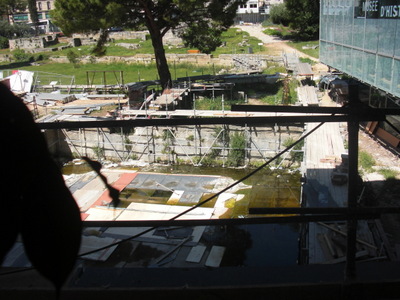
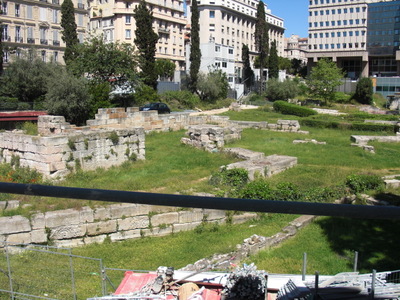 When I reported back to David at the bookstore, he chose to go back to the hotel and nap until lunch time. I therefore had almost an hour to kill, and a little rummaging through the brochures I'd collected revealed that the ruins of the original 600 BC Greek port of Marseille could be seen in a garden in the middle of the Centre de la Bourse shopping mall, not far away. I therefore hurried over there, to find the mall shrouded in scaffolding (next month's gala reopening . . .), but I found a way in and asked at the information desk where I could find the ruins and their little museum. Right over there, but closed for renovation before next month's gala opening . . . Drat.
When I reported back to David at the bookstore, he chose to go back to the hotel and nap until lunch time. I therefore had almost an hour to kill, and a little rummaging through the brochures I'd collected revealed that the ruins of the original 600 BC Greek port of Marseille could be seen in a garden in the middle of the Centre de la Bourse shopping mall, not far away. I therefore hurried over there, to find the mall shrouded in scaffolding (next month's gala reopening . . .), but I found a way in and asked at the information desk where I could find the ruins and their little museum. Right over there, but closed for renovation before next month's gala opening . . . Drat.
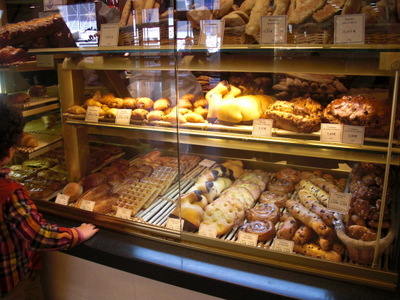
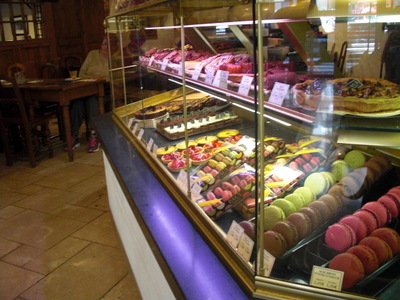 I couldn't go to the museum, but I could shove my camera lens through gaps in the construction fence. On the left, above, is the view I could get from the side nearest the information desk (you can see one edge of the museum building along the upper right-hand edge of the photo). On the right is a view I got at right angles to this one, through a different gap in the fence, that excludes most of the scaffolding.
I couldn't go to the museum, but I could shove my camera lens through gaps in the construction fence. On the left, above, is the view I could get from the side nearest the information desk (you can see one edge of the museum building along the upper right-hand edge of the photo). On the right is a view I got at right angles to this one, through a different gap in the fence, that excludes most of the scaffolding.
Here, on the left and right, you can see the cases of a Paul bakery I found in the mall. One of my favorite chains. When we travel by train in France, I always try to assemble our picnic at Paul, though we often have to settle for a Brioche Dorée instead these days, and that's not bad.
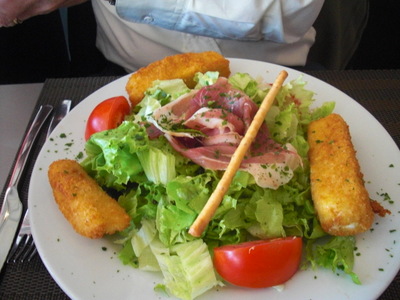
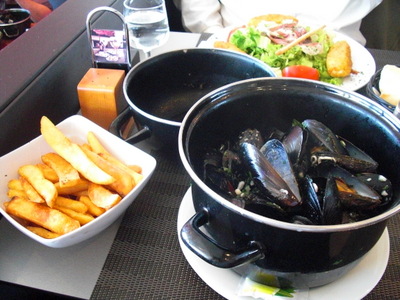 For lunch, we chose Brasserie du Soleil, another of those lining the head of the port. David chose a salad with "mozzarella en carosse," the French rendering of a fanciful Italian name for breaded and fried mozzarella: "mozzarella in a carriage." He wasn't thrilled with it—they seem to fry the cheese up ahead of time, then just reheat it, so it comes out pretty leathery.
For lunch, we chose Brasserie du Soleil, another of those lining the head of the port. David chose a salad with "mozzarella en carosse," the French rendering of a fanciful Italian name for breaded and fried mozzarella: "mozzarella in a carriage." He wasn't thrilled with it—they seem to fry the cheese up ahead of time, then just reheat it, so it comes out pretty leathery.
I ordered the special of the day, which was that old classic mussels and fries. In the photo, you'll notice little white things all over the mussels (in addition to the occasional worm tube). Those get denser get deeper into the pot of mussels, and they are pure coarsely chopped garlic! As far as I can tell, those mussels were steamed with very little liquid (white wine maybe?), a handful of chopped fresh parsley, and diced garlic, about a clove for every four mussels, that had been slow simmered beforehand. Man, were they good! Those were the best mussels I've ever eaten; maybe I can get the group to go back there next week, when we're back in Marseille.
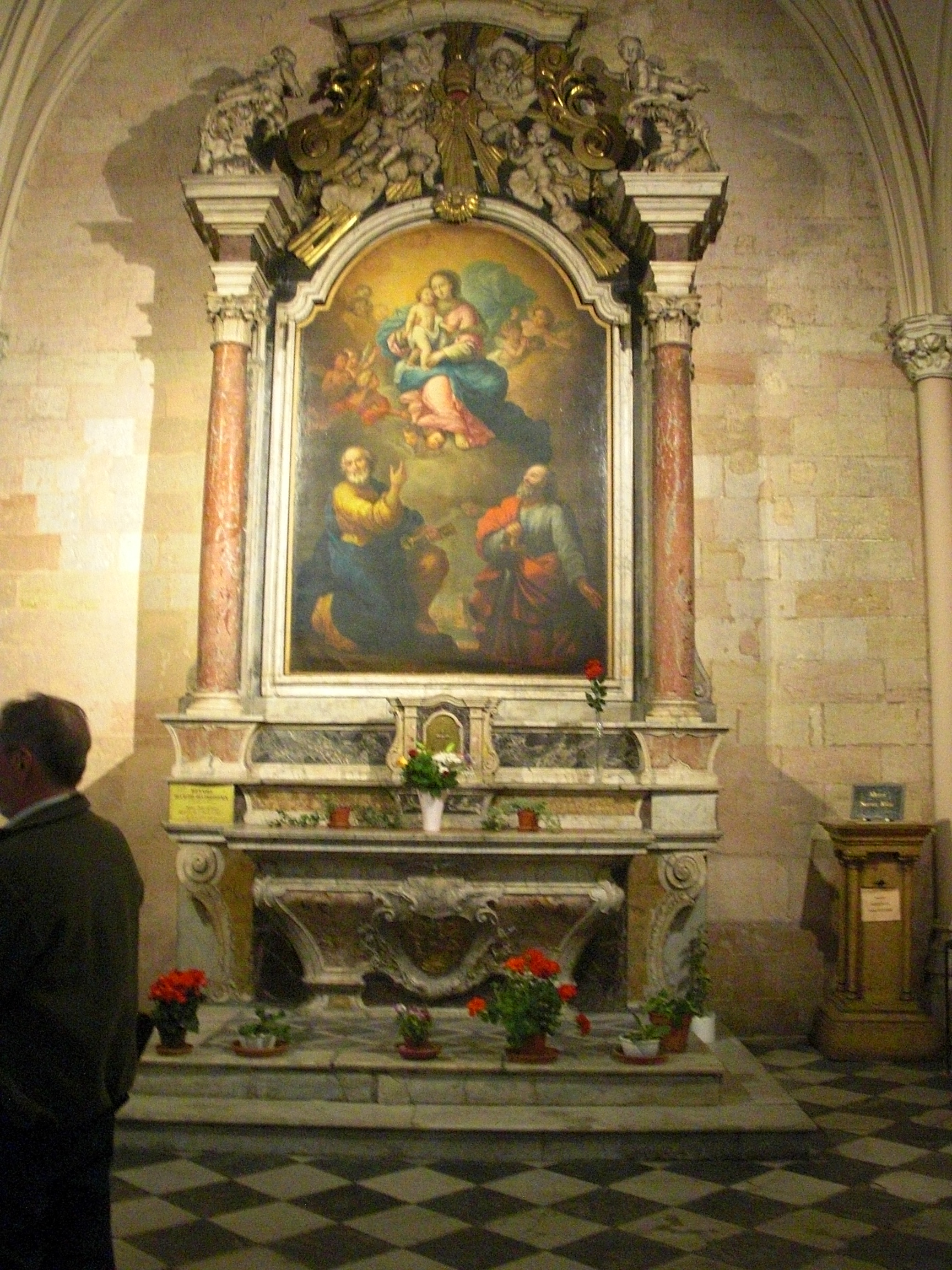
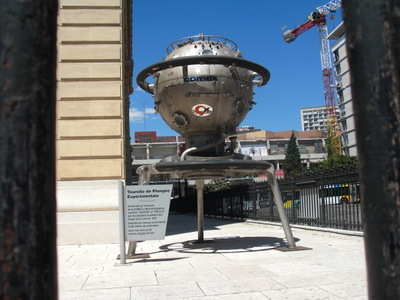 It was still very early for the tour, so set out to tour the church with the white façade at the head of the port, but on the way we were drawn aside by another brass band, busking on the promenade. This one was larger, about 20 kids, and called itself Fanfare Piston ("fanfare" means "brass band" in French). They claimed to be from the "central school" in Lyon. They were having fun and were fun to listen to, but they were nowhere near as good as Vivo Montana. One puzzling feature was that one of their sousaphones was twisted so that its bell faced backwards; the player therefore stood with his back to the audience, so that the bell faced us!
It was still very early for the tour, so set out to tour the church with the white façade at the head of the port, but on the way we were drawn aside by another brass band, busking on the promenade. This one was larger, about 20 kids, and called itself Fanfare Piston ("fanfare" means "brass band" in French). They claimed to be from the "central school" in Lyon. They were having fun and were fun to listen to, but they were nowhere near as good as Vivo Montana. One puzzling feature was that one of their sousaphones was twisted so that its bell faced backwards; the player therefore stood with his back to the audience, so that the bell faced us!
After a few numbers, we went on to the church, saint Ferréol. As far as we could tell it was just a hard-working little local church. In a side chapel was this painting of Our Lady of Grace being implored by Saints Peter and Paul.
From there, I took David up to peer through the construction fence at the Greek ruins, and we took time to photograph the "experimental diving towerlet" on display next to the Chamber of Commerce (one of a pair, named Castor and Pollux, constructured in the Loire valley in 1967, intended for undersea exploration to a depth of 300 meters), in turn next door to the tourist office, but we still wound up waiting for a good half hour before our walking tour. I took the time to study the wonderful fish poster on display there and to ask at the desk about the best strategy for buying tickets for the Frioul-If ferry.
When we finally set off on the walking tour, our guide, Sylvie, walked our feet off but gave excellent, clear, audible, understandable narration—an excellent guide. On the way to the old-town section, she pointed out the Rue de la République, which in the 19th century was cut straight as a die through a tangle of older streets, specifically to connect the old port with the new one north of town. In the process, she explained who the nave of Saint Ferréol is shorter than standard: the builders of the Rue de la République simply chopped the end of the church off to make way for the street's arrival at the old port. They did the same thing with all the older buildings in their way—truncated or demolished them. The church's present white facade was added as a repair.
Crossing a street, we enountered, coming the other way, a group of about five cheerful and boistrous Brazilians in native dress, carrying drums of various sizes. We hoped to encounter them later, playing the drums, and in fact we did come across them two days later in Aix-en-Provence, but once again, they were just crossing the street.
Written Thursday, 16 May 2013
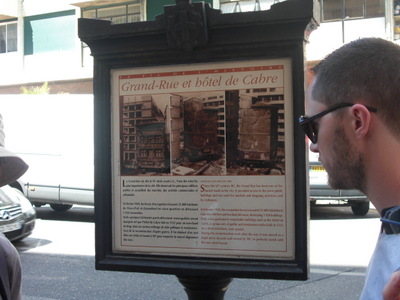
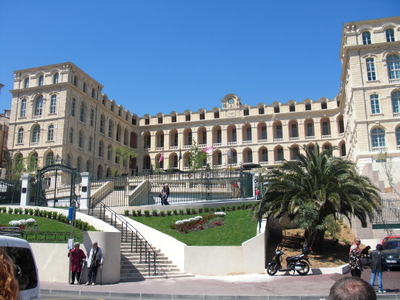 Once in the old town (called the "panier," i.e., basket, apparently because of some prominent business located there whose sign featured a basket), Sylvie showed us the oldest building in Marseille (the Medieval Cabre house) and the nearby Hotel Continental, now occupying the building originally built as a charity hospital for the poor of the city. We'd seen both on the open-top bus tour, but Sylvie took the time to supply much more information. She started by pointing out the the street name carved in the stones on one side of the Medieval building was on the wrong side, 90° from the actual street of that name. The historical marker show at the left here shows how that happened. During WWII, the occupying Germans found the building's orientation inconvenient to their redevelopment plans. They clearly planned to be in Marseille for the long term, because rather than tearing it down, they took the time, trouble, and expense, right in the middle of the war, to uproot the several-story stone building and turn it 90° so that it could be preserved!
Once in the old town (called the "panier," i.e., basket, apparently because of some prominent business located there whose sign featured a basket), Sylvie showed us the oldest building in Marseille (the Medieval Cabre house) and the nearby Hotel Continental, now occupying the building originally built as a charity hospital for the poor of the city. We'd seen both on the open-top bus tour, but Sylvie took the time to supply much more information. She started by pointing out the the street name carved in the stones on one side of the Medieval building was on the wrong side, 90° from the actual street of that name. The historical marker show at the left here shows how that happened. During WWII, the occupying Germans found the building's orientation inconvenient to their redevelopment plans. They clearly planned to be in Marseille for the long term, because rather than tearing it down, they took the time, trouble, and expense, right in the middle of the war, to uproot the several-story stone building and turn it 90° so that it could be preserved!
The surprising information she imparted about the Intercontinental was that it had only been open a week! It's yet another establishment preparing for the June festivities.
The Cabre house is now in the middle of a huge area north of the old port that's covered with well-organized, carefully spaced, matching 1950's appartment buildings. The bus tour narration said they were built after the area was "destroyed during the war." What Sylvie added is that the destruction did not arise from bombing, as we had assumed. Instead, during the occupation, the Germans judged that that area was the source of a great deal of disease, prostitution, and crime (and probably resistance) as, in fact, it was and simply bulldozed it. They evacuated the population, closed all the businesses, dynamited the buildings, and leveled the site. In the process, they discovered the remains of the Roman docks, part of which are now displayed in the museum we visited, but before they could proceed with their plans for the area, the war ended. The French brought in three celebrated architects to rebuild (preserving what they could of the ruins underneath. The Germans had spared only the town hall (the one with no stairs to the second floor), its adjacent administration buildings, and the Cabre house, so they now sit, a little incongruously, among all those 1950's buildings. On the way past, the guide pointed out the curvature of the retaining wall below the street we were walking on, explaining that it was the curvature of the original Greek theatre that stood on the site (did I mention that Marseille was founded by the Greeks, ca. 600 BC?). At the foot of the wall, was the junior high she went to, where, in her day, a few rows of the roman theatre seats were visible, but she says they're no longer exposed to view.
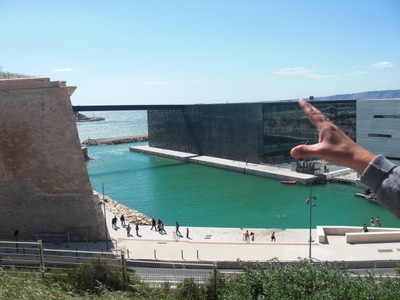
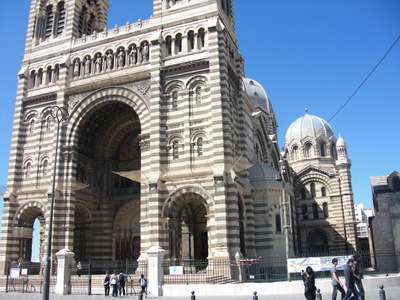 Further along, at the Fort Saint Jean (the one facing the one we visited, on the other side of the port) we couldn't go in because of ongoing renovation, but we viewed the new building attached to it by a slender footbridge. The new building will vastly expand the area available for the museum of the Mediterranean now crammed into the fort, and because of its low profile and position seaward of the fort, it's not visible from the old port, so it doesn't disrupt its ambience. The wall facing the fort (right behind Sylvie's pointing finger) is the one built of the new, carvable concrete, here carved into lace. People were swimming in the basin between the two buildings, and Sylvie assured us that, at the same time the previous week, when she had led a tour past it, that swimming area was not yet open.
Further along, at the Fort Saint Jean (the one facing the one we visited, on the other side of the port) we couldn't go in because of ongoing renovation, but we viewed the new building attached to it by a slender footbridge. The new building will vastly expand the area available for the museum of the Mediterranean now crammed into the fort, and because of its low profile and position seaward of the fort, it's not visible from the old port, so it doesn't disrupt its ambience. The wall facing the fort (right behind Sylvie's pointing finger) is the one built of the new, carvable concrete, here carved into lace. People were swimming in the basin between the two buildings, and Sylvie assured us that, at the same time the previous week, when she had led a tour past it, that swimming area was not yet open.
At the right is a better view of the facade of the cathedral. We had already seen, up on the hill with Fort Saint Jean, the church where masses are now celebrated (Saint Laurent). The cathedral is apparently still officially the cathedral, although mass is no longer said there. That's why, in the course of the restoration of the arcades that support the platform on which it was built, no one objects that a discotheque is being installed under one of the arches. The smaller building at the right edge of the photo is the old cathedral that this one replaced, truncated for the process.
Across the street from the cathedral (out of sight to the right of the photo) is the old episcopal palace, now a police station—the police station used in The French Connection. The guide assured us that those with sharp eyes and a good knowledge of the movie should be able to spot a number of shooting locations throughout the old town, which is the district north of the old port, behind that area that the Germans flattened.
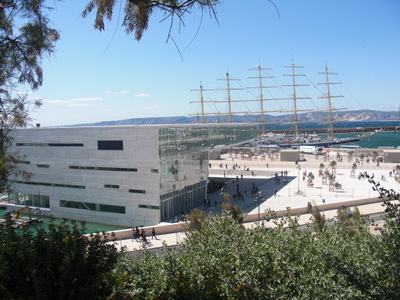
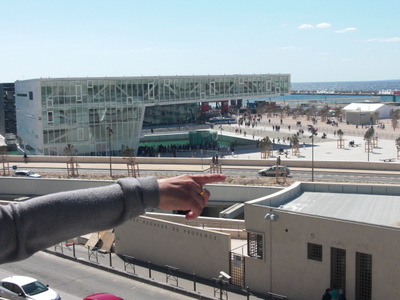 Next door to MuCEM (the new museum pictured above) is the amazingly cantilevered "Villa Mediterranée, also not yet open. The photo on the left is framed mostly to show the beautiful five-masted sailing vessel moored in front of it (a newly arrived cruise ship, Sylvia said, having come in just that morning). The photo at the right, also featuring Sylvie's pointing arm, is at a better angle for showing the building's amazing cantilever. Must be interesting to have an office sticking out over nothing like that!
Next door to MuCEM (the new museum pictured above) is the amazingly cantilevered "Villa Mediterranée, also not yet open. The photo on the left is framed mostly to show the beautiful five-masted sailing vessel moored in front of it (a newly arrived cruise ship, Sylvia said, having come in just that morning). The photo at the right, also featuring Sylvie's pointing arm, is at a better angle for showing the building's amazing cantilever. Must be interesting to have an office sticking out over nothing like that!
As we came back down the hill past the Hôtel de Ville, Sylvie explained the painted fiberglas animals. It seems that the Natural History Museum, housed in that amazing structure on top of the hill that serves as the town's water tower, used to have a small zoo behind it. The animals are long gone, but the cages remain as a sad reminder of the bad old days of zookeeping. Artists were invited to paint and otherwise decorate the fiberglas animals for the grand opening of Cultural Capital 2013; after that, the painted animals will be put into the old cages to cheer up the view.
While we were there, I asked about the lion and the bull at the Hôtel de Ville. Each is an absolutely classical life-size rendering in bronze, but each one is raised on stilts to stand about 10 feet off the ground. The foot of each stilt is set into a 55-gallon iron drum. When we arrived in town, they were set out front of the building; by the time of the tour they had been moved to the sides. When I asked Sylvie, she explained straight-faced that the lion and the bull were the mascots of the town. Yes, I'd caught onto that, but what's with the Dali-esque stilts? Is that a permanent arrangement? No, no, she said, just an artistic installation. Probably not permanent, and they keep moving around.
I've given very short shrift to what was a very thorough tour. Among the other things we saw were the Place des 13 Cantons, a little square named by someone who was a native of Switzerland. A bar there is called "Les 13 coins" (i.e., "the 13 corners"), a corruption of the name of the square. We through the Place des Moulins ("Mill Square"; note that I translate "place" as "square," but most of them aren't square; it really means something more like "open space bigger than a street corner"), at the very top of the city's highest hill, where you can still see the vestiges of the numberous windmills that used to be up there. North of the new museums and the Villa Med was a vast, long building sticking out over the ocean on pilings, le Vieux Sanitaire (the old building where, at some point in history—within living memory, I think—all travellers arriving in Marseille (at least by sea) had to strip naked and undergo a medical checkup while their clothes were being laundered, as a precaution against contagious diseases. Thanks to a rich donor, it has now been remodeled into another new art museum, and has actually opened, but it's far from the center of things, and we were running out of time, so we never got up there. Another museum has been opened, in a temporary wooden structure next to the Hôtel de Ville, just for the Cultural Center festivities, but it contains only modern art, not our favorite.
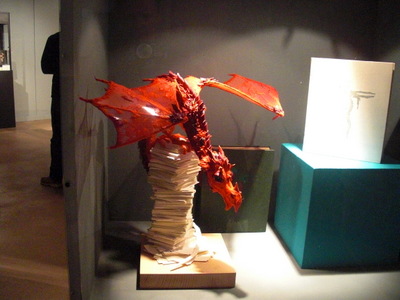
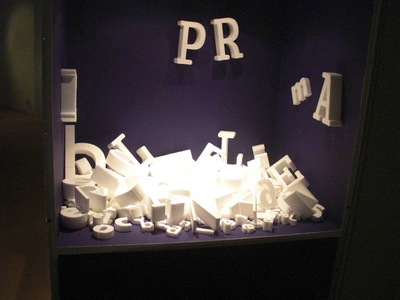 At this point, David's feet were killing him, so we headed back to the hotel. He went to take a nap, while I at last visited the "arts and crafts" museum—not at all what I expected, but worth seeing nonetheless, especially because it's free.
At this point, David's feet were killing him, so we headed back to the hotel. He went to take a nap, while I at last visited the "arts and crafts" museum—not at all what I expected, but worth seeing nonetheless, especially because it's free.
The constents consisted entirely of the current temperorary exhibition "Capital Letters." Originally, poets (artists) and bookbinders (craftspersons) were invited to make 26 books, each with 26 pages, celebrating the alphabet, particular the capital letters. (In French, the ordinary word for "capital" in this sense is "majuscule," so their calling it "Lettres Capitals" is a pun on "capital" in the sense of excellent.) Many of those involved got carried away, so in the end not every exhibit was a book.
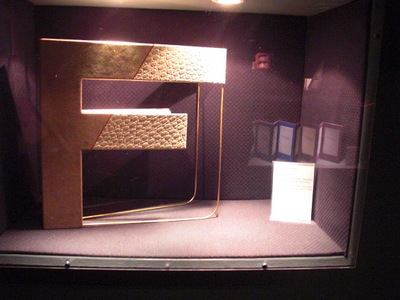
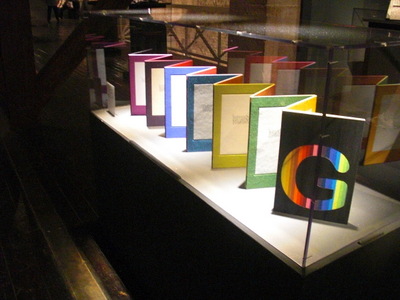 At the left, above, is a unique hand binding of The Hobbit accompanied by something that might or might not be called a binding of the tall stack of paper (presumably from The Hobbit). The dragon is made of wire, lace, paper, acrylic paint, etc., and the end of his tail, curling around in front of the bottom of the stack is made of plain, white paper.
At the left, above, is a unique hand binding of The Hobbit accompanied by something that might or might not be called a binding of the tall stack of paper (presumably from The Hobbit). The dragon is made of wire, lace, paper, acrylic paint, etc., and the end of his tail, curling around in front of the bottom of the stack is made of plain, white paper.
Above right, is a jumbled heap of letters (made of styrofoam) from about three inches tall down to eensy tiny. Too bad the glare off the glass front of the case obscures the middle of the pile.
At the left below the dragon is a book on the theme of the letter "F." I think the poets got short changed, because few of the books were open wide enough to let you read the text. At the right is one on the theme of "G," more satisfactory because its "accordion" style binding allows it to stand open and be readable. All 26 of its calligraphed and numbered pages were legible.
The binders had produced beautiful cases, as well as covers, for many of the books. One had no "cover"; it consisted of a tall red wooden box with a large "i" on the front. The back of the box was open, and the loose-leaf pages, each two-hole punched at the top, were hung inside on a pair of wooden pegs. A few had been brought out so that their calligraphy could be seen. Altogether a lovely exhibition in an old stone building with huge exposed beams. The only odd note was a quote painted on one wall that said, "If you want to learn the greatest truth, begin with the alphabet." Fine, except that it was labeled "Japanese proverb"—am I not right that Japanese does not have, and has never had, an alphabet? Any readers out there know better?
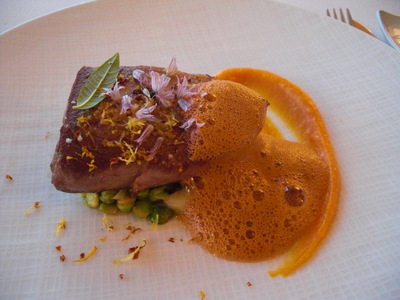 For dinner, we went back to Une Table Au Sud (note to sticklers: in fact, the restaurant writes its name with a comma after "Table," but that comma screws up the punctuation of every sentence in which I mention it, so I'm leaving it out. So there.)
For dinner, we went back to Une Table Au Sud (note to sticklers: in fact, the restaurant writes its name with a comma after "Table," but that comma screws up the punctuation of every sentence in which I mention it, so I'm leaving it out. So there.)
This time, we ordered the three-course suprising tasting menu, which David thought was great, but which I found disappointing because two of the three courses duplicated those I had ordered two days earlier. Let this be a lesson to us always to order the surprise menu on the first visit, so that you can avoid duplication and get to try more dishes. The first course was the foie gras with blood-orange sorbet that I started with on Thursday, and the dessert was the pistachio and grapefruit parfait I had then. The main course, shown here, was a slab of grilled fresh Mediterranean tuna served with a sweet puré of carrot, on a bed of individually peeled fresh green peas, sprinkled with lemon peel and chive flowers (and a lemon verbena leaf), and napped with an emulsion of bouillabaise. Nicely rare in the center.
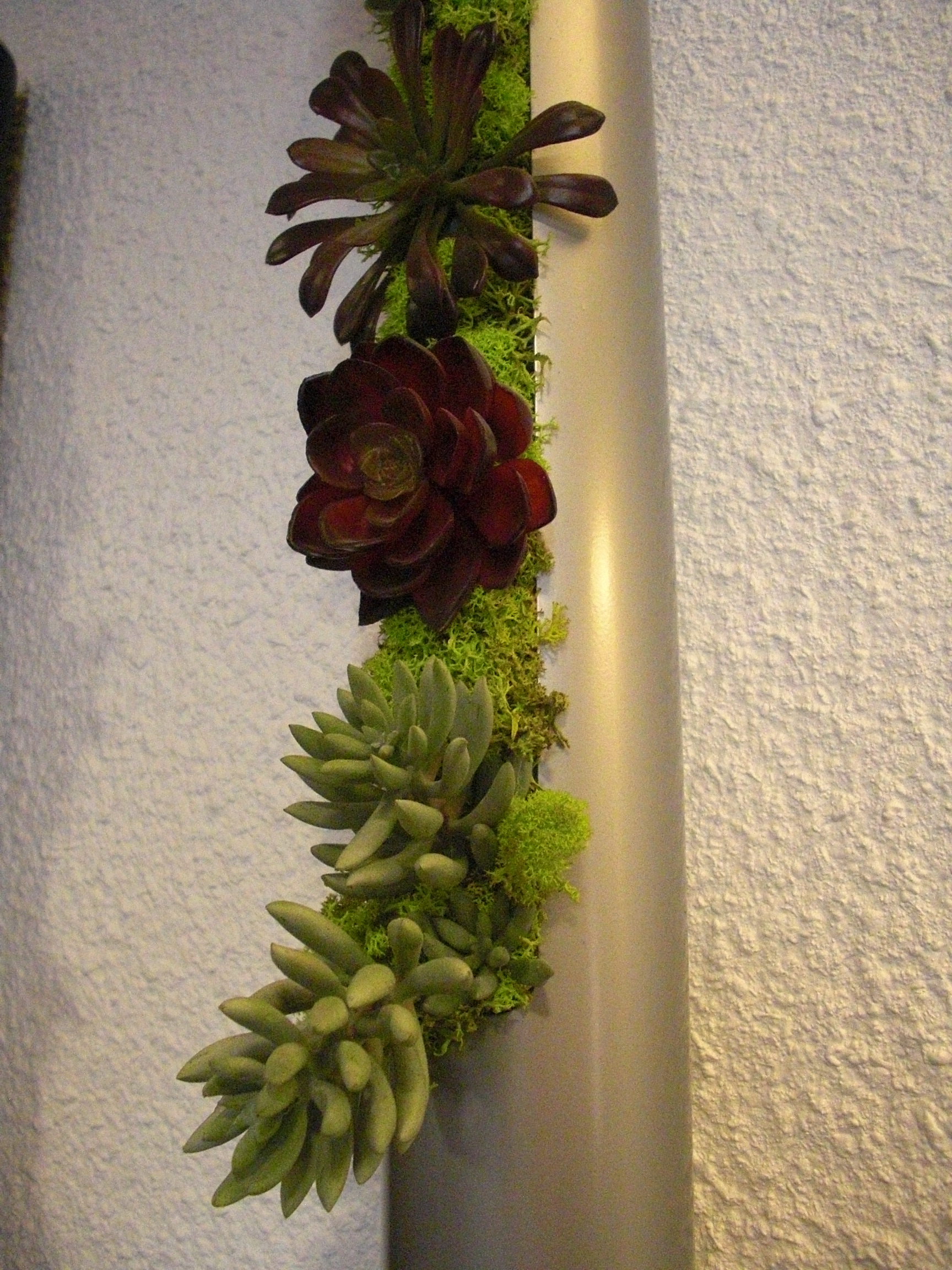
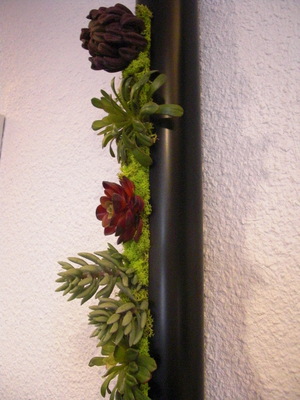 Here, just by way of eye candy, are close-up photos of two arrangements of small potted plants hung on the wall in our hotel's lobby. Fun.
Here, just by way of eye candy, are close-up photos of two arrangements of small potted plants hung on the wall in our hotel's lobby. Fun.
previous entry
List of Entries
next entry

 When I reported back to David at the bookstore, he chose to go back to the hotel and nap until lunch time. I therefore had almost an hour to kill, and a little rummaging through the brochures I'd collected revealed that the ruins of the original 600 BC Greek port of Marseille could be seen in a garden in the middle of the Centre de la Bourse shopping mall, not far away. I therefore hurried over there, to find the mall shrouded in scaffolding (next month's gala reopening . . .), but I found a way in and asked at the information desk where I could find the ruins and their little museum. Right over there, but closed for renovation before next month's gala opening . . . Drat.
When I reported back to David at the bookstore, he chose to go back to the hotel and nap until lunch time. I therefore had almost an hour to kill, and a little rummaging through the brochures I'd collected revealed that the ruins of the original 600 BC Greek port of Marseille could be seen in a garden in the middle of the Centre de la Bourse shopping mall, not far away. I therefore hurried over there, to find the mall shrouded in scaffolding (next month's gala reopening . . .), but I found a way in and asked at the information desk where I could find the ruins and their little museum. Right over there, but closed for renovation before next month's gala opening . . . Drat. 
 I couldn't go to the museum, but I could shove my camera lens through gaps in the construction fence. On the left, above, is the view I could get from the side nearest the information desk (you can see one edge of the museum building along the upper right-hand edge of the photo). On the right is a view I got at right angles to this one, through a different gap in the fence, that excludes most of the scaffolding.
I couldn't go to the museum, but I could shove my camera lens through gaps in the construction fence. On the left, above, is the view I could get from the side nearest the information desk (you can see one edge of the museum building along the upper right-hand edge of the photo). On the right is a view I got at right angles to this one, through a different gap in the fence, that excludes most of the scaffolding.
 For lunch, we chose Brasserie du Soleil, another of those lining the head of the port. David chose a salad with "mozzarella en carosse," the French rendering of a fanciful Italian name for breaded and fried mozzarella: "mozzarella in a carriage." He wasn't thrilled with it—they seem to fry the cheese up ahead of time, then just reheat it, so it comes out pretty leathery.
For lunch, we chose Brasserie du Soleil, another of those lining the head of the port. David chose a salad with "mozzarella en carosse," the French rendering of a fanciful Italian name for breaded and fried mozzarella: "mozzarella in a carriage." He wasn't thrilled with it—they seem to fry the cheese up ahead of time, then just reheat it, so it comes out pretty leathery.
 It was still very early for the tour, so set out to tour the church with the white façade at the head of the port, but on the way we were drawn aside by another brass band, busking on the promenade. This one was larger, about 20 kids, and called itself Fanfare Piston ("fanfare" means "brass band" in French). They claimed to be from the "central school" in Lyon. They were having fun and were fun to listen to, but they were nowhere near as good as Vivo Montana. One puzzling feature was that one of their sousaphones was twisted so that its bell faced backwards; the player therefore stood with his back to the audience, so that the bell faced us!
It was still very early for the tour, so set out to tour the church with the white façade at the head of the port, but on the way we were drawn aside by another brass band, busking on the promenade. This one was larger, about 20 kids, and called itself Fanfare Piston ("fanfare" means "brass band" in French). They claimed to be from the "central school" in Lyon. They were having fun and were fun to listen to, but they were nowhere near as good as Vivo Montana. One puzzling feature was that one of their sousaphones was twisted so that its bell faced backwards; the player therefore stood with his back to the audience, so that the bell faced us!
 Once in the old town (called the "panier," i.e., basket, apparently because of some prominent business located there whose sign featured a basket), Sylvie showed us the oldest building in Marseille (the Medieval Cabre house) and the nearby Hotel Continental, now occupying the building originally built as a charity hospital for the poor of the city. We'd seen both on the open-top bus tour, but Sylvie took the time to supply much more information. She started by pointing out the the street name carved in the stones on one side of the Medieval building was on the wrong side, 90° from the actual street of that name. The historical marker show at the left here shows how that happened. During WWII, the occupying Germans found the building's orientation inconvenient to their redevelopment plans. They clearly planned to be in Marseille for the long term, because rather than tearing it down, they took the time, trouble, and expense, right in the middle of the war, to uproot the several-story stone building and turn it 90° so that it could be preserved!
Once in the old town (called the "panier," i.e., basket, apparently because of some prominent business located there whose sign featured a basket), Sylvie showed us the oldest building in Marseille (the Medieval Cabre house) and the nearby Hotel Continental, now occupying the building originally built as a charity hospital for the poor of the city. We'd seen both on the open-top bus tour, but Sylvie took the time to supply much more information. She started by pointing out the the street name carved in the stones on one side of the Medieval building was on the wrong side, 90° from the actual street of that name. The historical marker show at the left here shows how that happened. During WWII, the occupying Germans found the building's orientation inconvenient to their redevelopment plans. They clearly planned to be in Marseille for the long term, because rather than tearing it down, they took the time, trouble, and expense, right in the middle of the war, to uproot the several-story stone building and turn it 90° so that it could be preserved!
 Further along, at the Fort Saint Jean (the one facing the one we visited, on the other side of the port) we couldn't go in because of ongoing renovation, but we viewed the new building attached to it by a slender footbridge. The new building will vastly expand the area available for the museum of the Mediterranean now crammed into the fort, and because of its low profile and position seaward of the fort, it's not visible from the old port, so it doesn't disrupt its ambience. The wall facing the fort (right behind Sylvie's pointing finger) is the one built of the new, carvable concrete, here carved into lace. People were swimming in the basin between the two buildings, and Sylvie assured us that, at the same time the previous week, when she had led a tour past it, that swimming area was not yet open.
Further along, at the Fort Saint Jean (the one facing the one we visited, on the other side of the port) we couldn't go in because of ongoing renovation, but we viewed the new building attached to it by a slender footbridge. The new building will vastly expand the area available for the museum of the Mediterranean now crammed into the fort, and because of its low profile and position seaward of the fort, it's not visible from the old port, so it doesn't disrupt its ambience. The wall facing the fort (right behind Sylvie's pointing finger) is the one built of the new, carvable concrete, here carved into lace. People were swimming in the basin between the two buildings, and Sylvie assured us that, at the same time the previous week, when she had led a tour past it, that swimming area was not yet open.
 Next door to MuCEM (the new museum pictured above) is the amazingly cantilevered "Villa Mediterranée, also not yet open. The photo on the left is framed mostly to show the beautiful five-masted sailing vessel moored in front of it (a newly arrived cruise ship, Sylvia said, having come in just that morning). The photo at the right, also featuring Sylvie's pointing arm, is at a better angle for showing the building's amazing cantilever. Must be interesting to have an office sticking out over nothing like that!
Next door to MuCEM (the new museum pictured above) is the amazingly cantilevered "Villa Mediterranée, also not yet open. The photo on the left is framed mostly to show the beautiful five-masted sailing vessel moored in front of it (a newly arrived cruise ship, Sylvia said, having come in just that morning). The photo at the right, also featuring Sylvie's pointing arm, is at a better angle for showing the building's amazing cantilever. Must be interesting to have an office sticking out over nothing like that!

 At this point, David's feet were killing him, so we headed back to the hotel. He went to take a nap, while I at last visited the "arts and crafts" museum—not at all what I expected, but worth seeing nonetheless, especially because it's free.
At this point, David's feet were killing him, so we headed back to the hotel. He went to take a nap, while I at last visited the "arts and crafts" museum—not at all what I expected, but worth seeing nonetheless, especially because it's free. 
 At the left, above, is a unique hand binding of The Hobbit accompanied by something that might or might not be called a binding of the tall stack of paper (presumably from The Hobbit). The dragon is made of wire, lace, paper, acrylic paint, etc., and the end of his tail, curling around in front of the bottom of the stack is made of plain, white paper.
At the left, above, is a unique hand binding of The Hobbit accompanied by something that might or might not be called a binding of the tall stack of paper (presumably from The Hobbit). The dragon is made of wire, lace, paper, acrylic paint, etc., and the end of his tail, curling around in front of the bottom of the stack is made of plain, white paper. For dinner, we went back to Une Table Au Sud (note to sticklers: in fact, the restaurant writes its name with a comma after "Table," but that comma screws up the punctuation of every sentence in which I mention it, so I'm leaving it out. So there.)
For dinner, we went back to Une Table Au Sud (note to sticklers: in fact, the restaurant writes its name with a comma after "Table," but that comma screws up the punctuation of every sentence in which I mention it, so I'm leaving it out. So there.)
 Here, just by way of eye candy, are close-up photos of two arrangements of small potted plants hung on the wall in our hotel's lobby. Fun.
Here, just by way of eye candy, are close-up photos of two arrangements of small potted plants hung on the wall in our hotel's lobby. Fun.